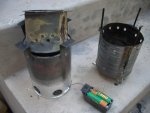I have to resurrect this thread to tell you how bummed I am...
I just started teaching high school physics this year, and I was planning on making a simple fire piston when we get to Thermodynamics (PV=nRT and all that).
Then yesterday I was really stoked to find a fire piston in the back of one of the cabinets (actually, it turns out the laboratory version is called a fire syringe).
It was made from a Pyrex tube so you could actually see the result of compression... The piston itself was an aluminum rod with a nice plastic handle on top and three o-rings at the bottom.
So, I grabbed a little 0000 steel wool, put it in the bottom of the Pyrex tube, and gave it a slam.
It was really cool to watch the steel wool flash and go up in smoke. :Wow1:
Second time I tried it the mouth of the Pyrex tube broke.
Bummer.
On closer inspection, I think there was supposed to be a rubber pad on the bottom of the handle. In my exuberance I must have slammed the handle into the top of the Pyrex tube.
Major bummer.
Maybe I can get the school to buy a replacement. My googling indicates that the science supply places make 'em out of Lexan rather than Pyrex now-a-days. I wonder why?

EDITED: you know, I re-read the original link to the 'model T' fire piston, and while I really like his overall design, I have to make a couple of observations. Two things I noticed that I would do differently, and I think they are related:
1. Epoxy-ing the o-ring in place would not only make it so you couldn't replace it when it wears out, but would also likely effect its elasticity, potentially effecting its ability to seal properly.
2. O-ring grooves should be square-cornered, not round. I used to work for an engineering firm that designed electronics for underwater use. Now, I can't site the proper groove dimensions for a particular o-ring size, but I do know that o-rings don't seal properly, or stay in place, in rounded grooves. But you don't have to take my word for it: pop the o-ring out of your favorite flashlight or whatever, and you'll see it sits in a square groove.
If you are going to try to make this fire piston, and don't have a lathe, maybe use a small flat file rather than his string method of sanding. Or warp the sandpaper around something square. Matter of fact, rather than messing with his jig I'd probably chuck the dowel in a drill to spin it, and use a small file to cut the groove. By leaving the 'hot' end of the rod a little long, you could chuck that end in the drill and not get a lot of wobble. Then cut it down after you get the groove cut. Know what I mean?
My guess is that his round grove was allowing the o-ring to roll out of position, so he epoxied the o-ring in place. A square groove would be the proper solution to the problem.
Or just use his syringe plunger method. I like that one a lot. Very simple.
Further Editing: OK, now I'm being nit-picky, but I don't see where he chamfered the inside top of the PVC cylinder, either. Using find sandpaper to round the inside edges of the top of the PVC would make it much easier to get the plunger started down the tube.




